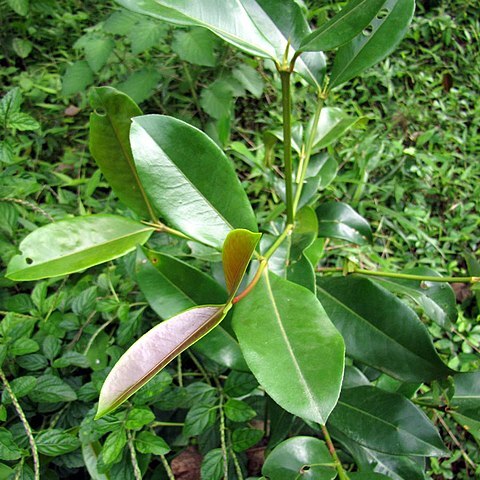A medium sized tree. It grows up to 5-15 m tall. Sometimes it has aerial roots. The bark is cream and thick. It has cracks along it and a corky texture. The branches are in pairs which cross at right angles. It has spreading branches which point upwards. It spreads to 3-6 m wide. It can occasionally have buttresses and aerial roots. The leaves are oval and broad. They are 7-14 cm long by 4-8 cm wide. The leaves are rich glossy green on top. They have a papery texture and the underside is covered with tiny black spots. The midrib is raised underneath the leaf. The leaf stalk is 1.2 cm long. The flowers are small and composed of 5-8 greenish petals up to 2 mm long. The flowers are borne in clusters in short woody stems. These are produced in the axils of leaves or on old wood. The fruit are succulent berries which are green but turn red when ripe. They are 0.6 cm across. The have persistent sepals at their crown. The ripe fruit are edible. There is one seed inside. It is 4-5 mm across.
Trees to 10 m tall. Branches brown, corky. Stipules 1-2.5 cm. Petiole ca. 1 cm; leaf blade elliptic, obovate, oblanceolate, or rarely suborbicular, 5-15 × 2-10 cm, papery to thinly leathery, base cuneate, margin entire, serrate, or denticulate, apex acute to shortly acuminate. Inflorescences 1-6 cm, often resinous, usually shining from secreted resin. Flowers shortly pedicellate or sessile; bracteoles 2 or 3, partially connate into a cup. Calyx lobes 6 or 7, deltoid, 3-4 mm. Petals white, suborbiculate, ca. 1.5 mm in diam., apically emarginate and unevenly lacerate. Stamens ca. 2 mm. Ovary bulbous, ca. 2 mm; style ca. 2 mm; stigma discoid, apically 4-8-lobed. Fruit pink to red globose, ca. 5 mm in diam., glossy. Seeds reniform. Fl. winter-spring, fr. spring-summer.
Tree to 20 m high, usually 5–8 m; bark brown, cork-like. Leaves: lamina elliptic, oblong or obovate, 5–15 cm long, 2–10 cm wide, cuneate base, entire margin, acute, acuminate or sometimes obtuse at apex, thin, black-spotted beneath; petiole to 1 cm long; stipules to 2.5 cm long. Inflorescence 1–6 cm long, often resinous; buds spherical. Flowers c. 3 mm long, crowded, sessile or on short pedicels; bracteoles 2 or 3, partially united into a cup. Sepals 1.5 mm long. Petals c. 1.5 mm long, white; lamina suborbicular, emarginate or unevenly lobed. Stamens c. 2 mm long. Ovary bulbous, c. 2 mm long; style 1.5–2.5 mm long; stigma discoid, lobed. Fruit globose, c. 7 mm diam., glassy, pink or red. Seeds reniform.


